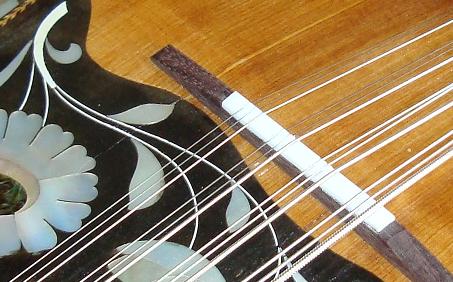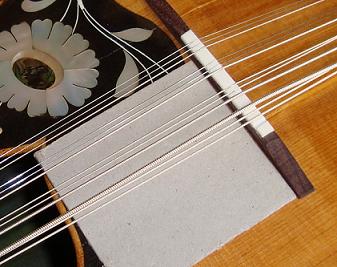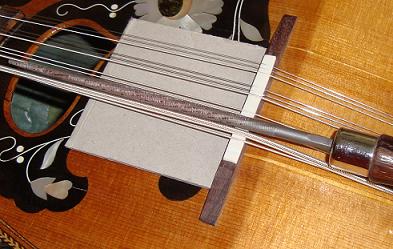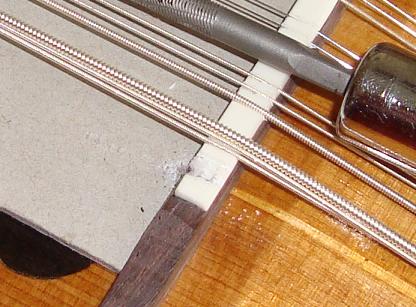|
Compensation |
|||
| It is only possible to add
compensation to a simple bridge with or without an integral saddle. It is not
possible with a shelf bridge.
The reason we might want to add compensation to a bridge is that, the thicker the string, the longer the distance it requires to vibrate at the required frequency. This is because the thickness tends to inhibit free vibration. Without compensation, some mandolins play sharp on some strings, and this effect gets worse the further up the fingerboard you play. Instruments with longer scale lengths tend to need compensation much less than a mandolin, and of course violinists compensate automatically.. Adding compensation is much easier on the instrument. Some bridges are sold with compensation added, but this is merely an average estimation, and will usually need to be adjusted when setting up the instrument. So, to start adding compensation, you will need to check the bridge position. This should be twice the distance of the nut to fret 12, plus 1-2mm. Check the intonation on the e string at the 12th fret. This is relatively easy these days with electronic tuners. The position of the bridge should be adjusted slightly, so that the intonation on the e string is perfect at fret 12. This is your bridge position and your starting point for compensation. Each string is then checked for intonation in turn. If the string is SHARP at fret 12, then a little compensation needs adding at the saddle. This is done carefully, as described below, with a file. Check intonation again, and keep filling and checking until the intonation at fret 12 is good. Repeat for each string.
|
|||
| Note 1: the amount of
compensation depends on the thickness of strings, but also on string
tension and playing height, so it cannot be calculated easily
mathematically. I have found instruments with lower tension, and lower
playing height require much less compensation.
Note 2: where compensation is needed, it is ALWAYS a compromise. It is almost impossible to have all strings in tune on all frets at the same time..... so don't feel you have failed if you have to settle for an approximation. If you think about it, if strings need a longer distance over which to vibrate to hit the note right, then strictly speaking we should be moving frets for individual strings also.... but obviously this is not easy, hence the instruments with fanned frets. So, it is always a compromise!! Note 3: when we talk of string thickness, the important element in wound strings is the core, not the overall width of the winding. |
|||
 |
Start by stringing up and tuning up the instrument. In this case a mandriola, but the principle is the same with mandolin or bouzouki. Once the bridge position has been checked, check intonation at fret 12 for each string. | ||
 |
When a string is found to be sharp when fretted at fret 12, it will need compensating. Slacken off the string until it can be moved to one side while the compensation is done. | ||
 |
Place a piece of card beneath the strings before you start to protect the top..... if necessary tape it in place. | ||
 |
Next select a suitable file with which to add compensation. For compensation of single strings, as on the mandriola, a round file, wider than the string is the best. Where you need to add compensation for two strings, as on a mandolin, then a half-round or narrow flat file is best. | ||
 |
File the entry of the string slot. If the string was badly sharp, then it will take 2-3mm, if it was less badly sharp, then go carefully. Replace the string, tune up, and check the intonation. If more compensation is needed (i. e. the string is still sharp at fret 12), then slacken off and repeat the process until it is no longer sharp, though angling the bridge slightly can also help, especially if the saddle is not too deep. | ||
 |
This is typical
mandolin bridge with compensation, done with a half-round file. The
first string (right) is not compensated; the second has 1-2mm; the third 1mm;
and the fourth typically 2-4mm.
Note that I also file the back of the saddle behind strings that are not compensated..... otherwise the saddle is often too wide and causes vibrations, rattles, and even string binding. |
||